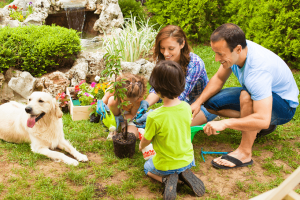Conserve Resources
The United States has just 4.25% of the world’s population, but uses about 19.4% of the earth’s energy resources.
 A lot of the energy we use at home, at school, and for our cars comes from fossil fuels like coal, oil, and natural gas. Most of our fossil fuel supply was created millions of years ago—much of it even before the dinosaurs were here. The earth has only a limited amount of these fuels and humans are using them up very fast. By saving energy, we can slow down the use of fossil fuels and make our supplies last longer.
A lot of the energy we use at home, at school, and for our cars comes from fossil fuels like coal, oil, and natural gas. Most of our fossil fuel supply was created millions of years ago—much of it even before the dinosaurs were here. The earth has only a limited amount of these fuels and humans are using them up very fast. By saving energy, we can slow down the use of fossil fuels and make our supplies last longer.
Saving energy conserves other resources as well. It takes a tremendous amount of natural resources (like water, land, wood, and other building materials) to build a power plant. Saving energy delays the need for new power plants and postpones the use of these resources.
You Can Help
- Use energy efficiently at home, at school, and for transportation. Simple things like carpooling and turning off the lights when you leave the room can make a big difference, if we all pitch in.
- Learn about and use energy from renewable resources. Renewable energy is energy that doesn’t get used up the way fossil fuels do. Renewable energy sources are sometimes called “green power” because they help keep our planet healthy. An example is solar energy, which uses renewable energy from the sun.
Keep Our Planet Healthy
 When fossil fuels are burned to produce energy, carbon dioxide is released. Carbon dioxide is one of the gases that causes the greenhouse effect. These gases act like a thin film that absorbs and traps heat from the sun inside our atmosphere.
When fossil fuels are burned to produce energy, carbon dioxide is released. Carbon dioxide is one of the gases that causes the greenhouse effect. These gases act like a thin film that absorbs and traps heat from the sun inside our atmosphere.
People’s activities (such as burning fossil fuels for electricity, heat, and transportation) have increased the greenhouse gases in our atmosphere. As a result, the earth’s temperature is rising. This is known as global warming. (Some scientists prefer the term climate change because in addition to higher temperatures, the earth is experiencing other changes such as new weather patterns like droughts and floods.)
Producing, transporting, and using fossil fuels and other forms of energy can also contribute harmful pollutants into our environment.
So no matter what resources your energy comes from, using energy efficiently at home, at school, and on the road is a very good way to reduce greenhouse gases and pollution and help our planet stay healthy!
Plant a Tree
 Trees take carbon dioxide out of the air and give back the oxygen we need to breathe. So, trees can help balance the effects of using energy. If every family in the United States planted just one tree, all of these trees would remove more than a billion (1,000,000,000) pounds of greenhouse gases from the air every year!
Trees take carbon dioxide out of the air and give back the oxygen we need to breathe. So, trees can help balance the effects of using energy. If every family in the United States planted just one tree, all of these trees would remove more than a billion (1,000,000,000) pounds of greenhouse gases from the air every year!
Recycle!
 Everyone knows that recycling helps the environment by reducing trash and saving space in our landfills, but did you know that recycling also saves energy?
Everyone knows that recycling helps the environment by reducing trash and saving space in our landfills, but did you know that recycling also saves energy?
- Producing new products from recycled materials uses about a quarter of the energy that is needed to make the same products from raw materials.
- Recycling one glass jar saves enough energy to light a 20-watt LED bulb for 20 hours.
- Recycling one aluminum can saves enough electricity to run an old-style TV for three hours.

What Can You Recycle?
Look for the recycle symbol, a design of three arrows that makes up a circle.
This symbol is located on the bottoms of bottles, cans, and jars that can be recycled. The three arrows in the symbol stand for the three steps in the recycling process in which recyclable materials are:
- Collected
- Manufactured into new items
- Sold to consumers
If your community does not pick up recyclable materials from your home, ask your family to take them to a nearby recycling center.

Reduce and Reuse, Too!
Here are some ways you can reduce waste and reuse items. Can you think of others?
- If you bring your lunch to school, pack it in a lunch box or reusable cloth bag.
- Try using both sides of every sheet of paper, cutting paper into smaller squares for notes, reusing envelopes, and other paper-saving techniques.
- When you shop, ask your parents to buy bulk products (products sold in large quantities) to save on packaging. You can bring your own reusable bags to most grocery stores and other shops.
- Give away your old toys and books instead of throwing them away.


